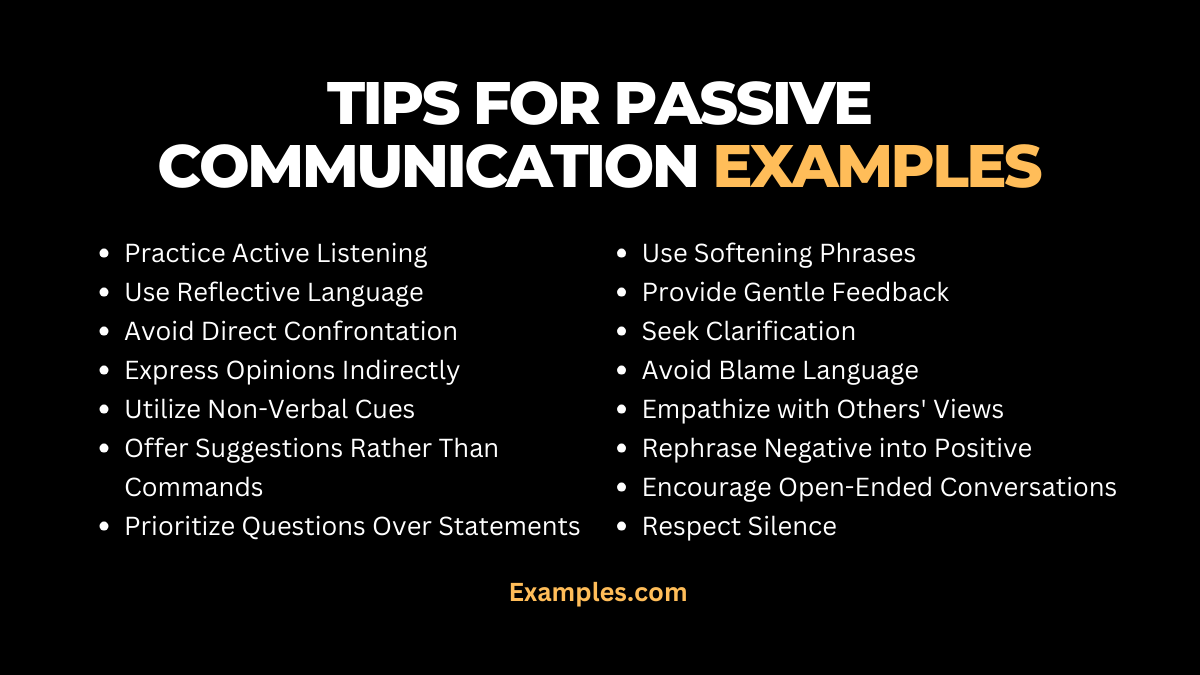Tips for Passive Communication
This comprehensive guide is dedicated to enhancing your Passive Communication skills, offering a range of practical tips and examples. Integrating the Passive element in communication is about expressing oneself thoughtfully and effectively, without resorting to direct confrontation. This guide will walk you through various techniques and scenarios where passive communication can be beneficial, from improving Interpersonal Relationships to navigating professional environments. By mastering these tips, you’ll learn to engage in more empathetic, understanding, and ultimately more effective communication, vital in today’s diverse and fast-paced world.
15 Tips for Passive Communication Examples

- Practice Active Listening: Focus on understanding the speaker fully before responding.
Example: “I hear what you’re saying; could you tell me more about that?” - Use Reflective Language: Mirror the speaker’s sentiments to show understanding.
Example: “It sounds like you feel strongly about this issue.” - Avoid Direct Confrontation: Frame your disagreements in a non-confrontational manner.
Example: “I see your point, but have you considered this alternative?” - Express Opinions Indirectly: Suggest rather than assert your views.
Example: “Perhaps there might be another way to approach this.” - Utilize Non-Verbal Cues: Communicate your feelings through body language and facial expressions.
Example: Nodding or showing concern through facial expressions during a discussion. - Offer Suggestions Rather Than Commands: Frame directives as suggestions.
Example: “Would it be helpful if we tried this method?” - Prioritize Questions Over Statements: Ask questions to invite dialogue and understanding.
Example: “What are your thoughts on this approach?” - Use Softening Phrases: Preface statements with phrases that soften the impact.
Example: “I might be wrong, but I was thinking that…” - Provide Gentle Feedback: Offer feedback in a way that is constructive and non-threatening.
Example: “I appreciate your work on this, maybe we could also consider…” - Seek Clarification: Clarify your understanding without assuming or accusing.
Example: “Just to make sure I understand, are you suggesting that…?” - Avoid Blame Language: Communicate issues without assigning blame.
Example: “There seems to be a misunderstanding here, let’s try to sort it out.” - Empathize with Others’ Views: Show empathy towards different perspectives.
Example: “I can see how that might be frustrating for you.” - Rephrase Negative into Positive: Turn negative statements into positive ones.
Example: “Instead of doing it this way, what if we try…” - Encourage Open-Ended Conversations: Use open-ended questions to explore topics deeply.
Example: “What are your feelings about this situation?” - Respect Silence: Understand the value of silence in conversations.
Example: Giving space for others to think before they respond.
Tips for Using Passive Communication in Healthcare

- Prioritize Patient Listening: Actively listen to patients’ concerns and symptoms without rushing to a diagnosis. This approach not only builds trust but also ensures a comprehensive understanding of the patient’s condition. Effective Communication in healthcare often starts with listening, allowing patients to express their concerns fully.
- Use Empathetic Language: Employ language that reflects understanding and empathy. Phrases like “I understand this must be difficult for you” can significantly ease patient anxiety, making the healthcare experience more Therapeutic.
- Explain Procedures Gently: When explaining medical procedures or treatment plans, use simple, non-technical language. This avoids overwhelming patients and ensures they understand their care process, crucial in Patient Education.
- Encourage Questions and Concerns: Invite patients to ask questions or express concerns. This not only clarifies any misunderstandings but also empowers patients in their healthcare journey, reinforcing the concept of Patient-Centered Care.
- Offer Reassurance: In situations of distress or uncertainty, provide reassurance to patients. Statements like “We are here to take care of you” can be comforting, reinforcing a sense of safety and care within the Healthcare Environment.
What are the Tips for Improving Passive Communication?
- Develop Active Listening Skills: Active listening is a cornerstone of Passive Communication. It involves fully concentrating on the speaker, understanding their message, providing feedback, and not rushing to respond. This skill is crucial for Effective Communication and ensures that you are genuinely engaging with the conversation.
- Practice Empathy: Empathy allows you to understand and share the feelings of others. In Passive Communication, showing empathy is key to building trust and rapport. It involves acknowledging others’ perspectives and feelings, which is especially important in Interpersonal Communication.
- Use Reflective Responses: Reflective responses involve paraphrasing or summarizing what the speaker has said to show that you understand. This technique not only validates the speaker’s feelings but also ensures clarity in communication.
- Avoid Interrupting: In Passive Communication, it’s crucial to let others express themselves without interruption. This shows respect for their opinions and encourages open dialogue, vital in maintaining Good Communication Skills.
- Adopt a Calm and Gentle Tone: The tone of your voice can greatly impact how your message is received. A calm and gentle tone is more likely to be received positively, which is particularly important in Therapeutic Communication.
How Can One Use Passive Communication Tips in a Leadership Role?

- Encourage Team Input: Leaders using passive communication effectively invite input from their team members. This not only fosters inclusivity but also encourages diverse viewpoints, crucial in Team Communication.
- Facilitate Open Discussions: Leaders can use passive communication to create a safe space for open discussions, where team members feel comfortable sharing their ideas and concerns. This approach is beneficial in Corporate Communication and team-building.
- Resolve Conflicts Diplomatically: Passive communication is key in conflict resolution. Leaders can mediate disputes by understanding all sides and guiding the parties towards a mutually beneficial resolution, an essential skill in Crisis Communication.
- Provide Constructive Feedback: Instead of direct criticism, leaders can offer constructive feedback in a way that is helpful and encouraging. This approach is vital in Professional Communication and helps in maintaining a positive work atmosphere.
- Lead by Example: Demonstrating passive communication techniques in their interaction, leaders set a precedent for the team. This influences the team’s communication style, fostering a respectful and productive environment essential in Leadership Communication.
In summary, this guide on Tips for Passive Communication offers a roadmap to mastering a communication style that is both gentle and effective. By embracing these techniques, individuals can enhance their interactions across various spheres, from personal relationships to professional leadership roles. Adopting passive communication fosters understanding, empathy, and respect, making it a powerful tool for building stronger, more harmonious connections.



